|
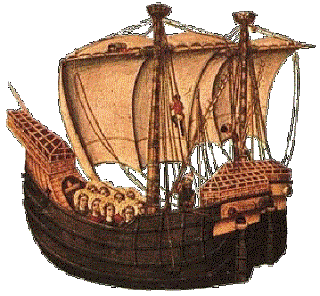 Since
Marco Polo returned to Europe with tales of the riches of the East,
Europeans longed for a passage to Asia. Spain’s obsession to find a
shorter route to the Asian wealth motivated expeditions for many years. Since
Marco Polo returned to Europe with tales of the riches of the East,
Europeans longed for a passage to Asia. Spain’s obsession to find a
shorter route to the Asian wealth motivated expeditions for many years.
In the year of 1521, two events
happened that made a route between Spain and Asia possible—Sebastián
Elcano, sailing with Fernando de Magellan, Portuguese navigator in the
service of Spain, discovered the Philippines, and Hernan Cortes
conquered Tenochtitlan, the capital of the Aztecs. Fifty years later,
these two remote lands would be connected by inter-oceanic commerce and
the commercial dream of Spain would be fulfilled.
The First Expeditions to the Orient
Spanish king, Charles I, yearned so much for a route to the Orient that
he sent two expeditions, one in 1520 and the other in 1525, around
Africa and through the Indian Ocean to India. Aside being immensely
expensive trips, both ended in failure.
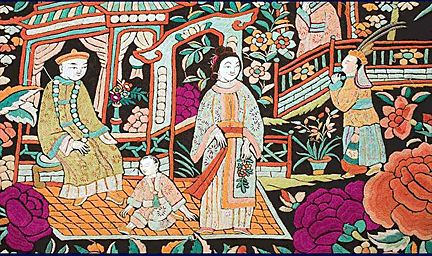 Trade
with New Spain through the port of Veracruz in New Spain had begun soon
after Cortes’ conquest. But as a result of the wars between Spain and
France, so had privateering and piracy against Spanish galleons. In
June, 1522, the Spanish Crown adopted Royal Provision 13, establishing
protection for the ships, with costs being shared among retailers on
both sides of the Atlantic. As of 1524, Spanish galleons sailed the
Atlantic in fleets under the protection of four armed galleons. Trade
with New Spain through the port of Veracruz in New Spain had begun soon
after Cortes’ conquest. But as a result of the wars between Spain and
France, so had privateering and piracy against Spanish galleons. In
June, 1522, the Spanish Crown adopted Royal Provision 13, establishing
protection for the ships, with costs being shared among retailers on
both sides of the Atlantic. As of 1524, Spanish galleons sailed the
Atlantic in fleets under the protection of four armed galleons.
The slowest ships determined the speed of the fleet. The flagship sailed
at the head of the convoy formed by about 30 ships. At night it ignited
to stern a great light that served as a guide to the rest of the ships
to form a column behind the flagship. The artillery ships sailed to
windward of the fleet. Captains and pilots, who deliberately allowed
their vessels to lose sight of the flagship or went off course, incurred
punishment, at first capital punishment that later was reduced to a
heavy fine, immediate loss of position and suspension from navigating
galleons for two years.
The number of ships crossing the Atlantic fleet differed from one year
to the next, depending on the necessities of commerce with New Spain and
the tonnage of the ships, as well as of the security of navigation as a
result of attacks by privateers. In 1522, only 18 ships left Seville,
Spain, but by 1549, 101 ships left that port bound for the Americas.
Though most were Spanish galleons, the Spanish Crown granted licenses to
particular foreign ships on an occasional basis. The galleons carried
100 tons of merchandise in the early years, with some carrying as much
as 200 tons. After 1548, most carried 200 tons, although there were
larger ships carrying 300, 400 and even 600 tons.
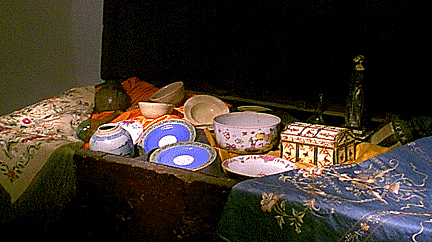 In
return for the exotic goods, Spain sent food, materials for farming,
cattle for ranching, and raw materials for manufacturing to New Spain.
Ships also carried cloth, clothes, glasses, cutlery, tools, and books.
Products shipped back to Spain included tobacco, cacao, chocolate,
indigo, Brazilian hardwoods, and leathers, and, of course, silver for
the king’s coffers. In
return for the exotic goods, Spain sent food, materials for farming,
cattle for ranching, and raw materials for manufacturing to New Spain.
Ships also carried cloth, clothes, glasses, cutlery, tools, and books.
Products shipped back to Spain included tobacco, cacao, chocolate,
indigo, Brazilian hardwoods, and leathers, and, of course, silver for
the king’s coffers.
Between 1521 and 1600 silver brought "legally" to Spain by the Spanish
fleets amounted to 17,000 tons, along with 181 tons of gold. The
galleons transported nearly 567 tons of silver and 87 tons of gold from
1521 to1560. Most of this went to pay for the enormous costs of the wars
of Charles I.
Establishing a Trade Route
So in 1542, he called on Viceroy Don Luis de Velasco to try to establish
a trade route to Asia from New Spain. The Viceroyalty of New Spain paid
for the construction of four great ships under the control of Ruy Lopez
de Villalobos with 370 crew on board.
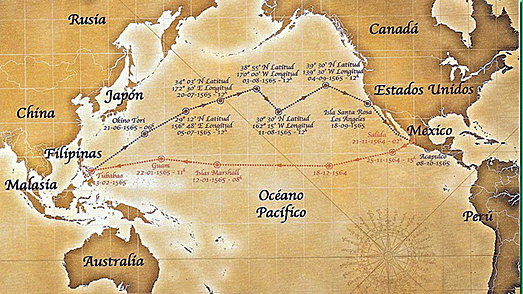 The
ships weighed anchor from Acapulco, taking advantage of the Ecuadorian
current that took them to Guam and on to the Marianas Islands, where
they took on food and water before continuing their trip to the
Philippines. But the problem was the return trip which took much too
long. The
ships weighed anchor from Acapulco, taking advantage of the Ecuadorian
current that took them to Guam and on to the Marianas Islands, where
they took on food and water before continuing their trip to the
Philippines. But the problem was the return trip which took much too
long.
Thus, the expeditions departed sporadically from Acapulco, until, in
1564, Philip II ordered Viceroy Velasco to prepare a new sailing armada
led by Don Miguel Lopez de Legazpi and the monk Agustino Andrés de
Urdaneta Legazpi stayed on in the Phillipines and founded Manila,
establishing the Philippines as a dependent territory of New Spain,
while Urdaneta established a viable return route to New Spain. With the
arrival of Urdaneta’s galleon, San Pedro, in Acapulco, Europe and the
Far East would finally be commercially connected by New Spain.
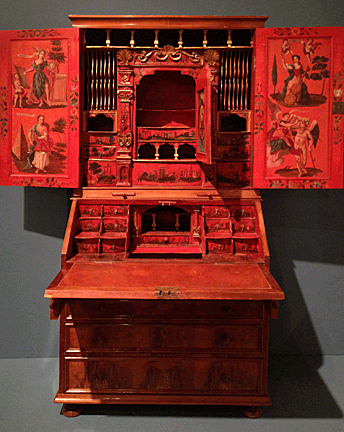 Urdaneta
found the marine currents which allowed his return to the American
continent by following the coast of Japan until he reached it, then
following it across the Pacific to the coast of California where he
turned south towards the Bay of Acapulco. Urdenata arrived on October 8,
1565, marking the beginning of the Philippine commercial route with
Acapulco that lasted more than 250 years. Urdaneta
found the marine currents which allowed his return to the American
continent by following the coast of Japan until he reached it, then
following it across the Pacific to the coast of California where he
turned south towards the Bay of Acapulco. Urdenata arrived on October 8,
1565, marking the beginning of the Philippine commercial route with
Acapulco that lasted more than 250 years.
From all parts of Mexico people of all social classes came to the port
of Acapulco to welcome the Galleon of Manila which they called the Nao
de China, and to buy or to trade silver for the wonderful silks,
fabrics, spices, jewels and other articles that the ship brought back
from the Orient.
Most of the ships that did this long passage were constructed in the
Philippines by Chinese carpenters, directed by European technicians,
using wood obtained in the forests of the islands. The shipbuilders had
metal parts, like ironworks, anchors, nails and chains forged in Japan,
China and India. Though these ships were expensive to build, they were
worth their high cost for the benefits they brought to the retailers in
both ports.
But the arduous trip presented many dangers—stormy seas, shipwrecks or,
if the passage were extended beyond the predicted length of four to
seven months, the possibility of dying of hunger and thirst. In fact,
many of the crew died from disease in the attempts. The fabulous
treasures that these ships transported also made them prey of English,
French and Dutch pirates. Queen Elizabeth I of England supported these
robberies because the crown obtained a considerable portion of the
booty. After being sacked, the ships were left, some burned. There are
also accounts of crew being taken prisoner, mutilated, even the raping
of women on board and the sacrificing of children, so that often the
once yearly Nao never reached Manila.
But investors forgot all the dangers when thinking of the wealth that
traveled in these ships. From Acapulco, the galleons carried silver bars
and currencies from Acapulco, sweet potatoes, tobacco, chick-peas,
chocolate and cacao, watermelon, grapevines and fig trees from New
Spain, and barrels of wine and olive oil from Spain.
The Return Trip
From Manila, the ships carried silk and porcelain from China, Persian
carpets of the Middle East, cotton fabric from India, lacquered fans,
large chests, coffers and jewelry boxes, combs and bells, and screens.
From the islands of Java and Ceylon, the sailors brought spices, mainly
nutmeg, pepper and cinnamon. The East also provided camel wool, wax, raw
and carved ivory from Cambodia, camphor from Borneo, rattans for
baskets,
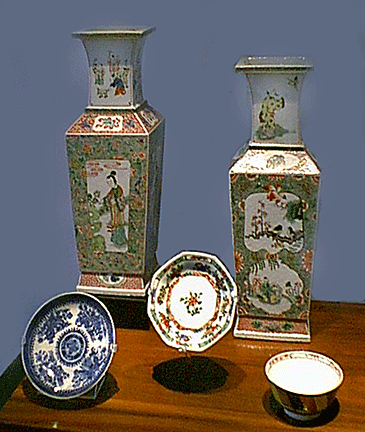 jade,
amber, precious stones from Burma, wood and cork, shells, iron, tin,
powder, and fruits of China. jade,
amber, precious stones from Burma, wood and cork, shells, iron, tin,
powder, and fruits of China.
Once delivered, the merchants transferred the merchandise to the
commercial centers to be sold. In Manila, they went to the Parián or
Fair of the Sangleyes, the center of the Asian market. In New Spain, the
Parian of Acapulco and, during the 18th century, the Parián of the Plaza
Mayor in Mexico City.
A good many of the Eastern products traveled overland by mule train
towards Veracruz for their voyage to Spain, with stops at markets in
Puebla and Jalapa, Veracruz. Some were distributed inland, towards the
silver mining centers and the important cities of the Bajio region north
of Mexico City. However, most of the Asian products were luxury goods
and only the wealthy families of New Spain had access to them. For
common people, the arrival of the exotic objects that "Nao de China"
brought became curiosities and often they went to the Parián to admire
precious lacquers, pieces of tortoise shell or silver, and large chests.
Nevertheless, in the 18th century, factories in New Spain began copying
the designs of Asian crafts, enabling more people to have access to
them.
Cultural Exchange
The Nao de China not only transported goods, but also enabled a cultural
interchange. New Spain soon adopted the use of the silk in rebozos
(shawls), fans and screens, the making of porcelain, the enamels in
dinner services and customs of Eastern origin such as cock fights.
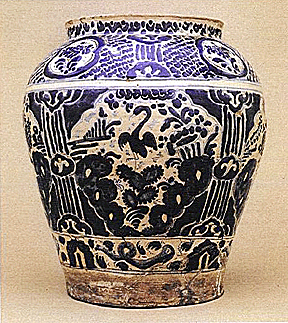 Also,
some Eastern people, mostly Filipinos, arrived as slaves of the
Spaniards. Unlike the black slaves from Africa, the Spanish brought them
to New Spain because of their aptitudes for certain artisan work and
other service occupations. The Spaniards defined them as "Chinese
Indians", and gave them the same rights as the indigenous population. In
New Spanish society, the Asians sold fabrics, candles, grass, brandy and
many were barbers. Also,
some Eastern people, mostly Filipinos, arrived as slaves of the
Spaniards. Unlike the black slaves from Africa, the Spanish brought them
to New Spain because of their aptitudes for certain artisan work and
other service occupations. The Spaniards defined them as "Chinese
Indians", and gave them the same rights as the indigenous population. In
New Spanish society, the Asians sold fabrics, candles, grass, brandy and
many were barbers.
The trip from Spain to the Orient and vice versa did not take place
freely. The management of all commercial traffic with America
concentrated in Seville, Spain, establishing a monopoly controlled by
the Consulate of Merchants of Seville, which managed the fleet offices,
controlled marine insurance, and rescued the merchandise from
shipwrecked ships. And in an attempt to prevent pirates from unloading
their booty illegally in New Spain, the Spanish Crown imposed a tax on
each foreign ship and each ton of merchandise that tried to enter the
province in an attempt to control the commerce of the zone.
Due to the Mexican War of Independence, Ferdinand VII of Spain halted
the trade route of the Pacific. In March of 1815, the Galleon Magellan,
the last Nao de China, weighed anchor for Manila, ending 250 years of
uninterrupted marine commerce between New Spain and the distant East.
< Back to
History Articles
|
